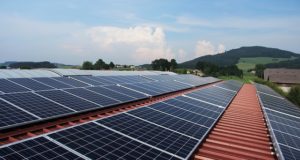 Solar power is a hot topic these days. With energy costs increasing and expected to keep on increasing, many are seeing solar power as the way to go. While expensive, it’s possible to add solar power to pretty much any home. But adding solar heating isn’t always all that easy, especially when that home wasn’t designed with solar in mind.
Solar power is a hot topic these days. With energy costs increasing and expected to keep on increasing, many are seeing solar power as the way to go. While expensive, it’s possible to add solar power to pretty much any home. But adding solar heating isn’t always all that easy, especially when that home wasn’t designed with solar in mind.
When most people talk about solar heated homes, they’re referring to passive solar. In a nutshell, passive solar works by the principle that dark colors absorb light. Since light is energy, the law of the conservation of energy tells us that the light must be converted to some other form of energy. This naturally occurs by converting the sunlight into heat. So, as long as a home is designed with enough windows, a good absorber and sufficient thermal mass, a passive solar heating system will work.
Unfortunately, not all homes lend themselves to passive solar heating. While many can be adapted to receive some benefit from passive solar, there are some with designs or locations that make it cost-prohibitive to modify them for passive solar.
Solar Heating
That’s where active solar comes in. Active solar heating works under the same basic principle as passive solar. However, that’s about the end of their similarity. The major difference between the two is that an active solar system has an “active” element, which moves the heat from the collector and absorber to the thermal mass or directly into the home.
Although not as common as passive solar heating systems, designs for active solar systems are literally endless. Some go as far as to have a swimming pool in the basement of the home, to be used as a thermal mass. However, it is possible to design a simple active solar heating system that doesn’t bother with a thermal mass. While this would only provide heating in daylight hours, in many parts of the country, that would be a help.
How The System Works
Most homes today have forced-air heating and cooling systems. There is an air handling unit which combines a blower, an evaporator for the air conditioning and either a burner (with natural gas) or an electric heating coil. This unit is the center of the home’s heating and cooling system, and it is controlled by a thermostat.
Harness the power of the sun when the power goes out…
To add active solar heating to such a system requires a solar collector, which will heat water from the sun, an additional heating coil to be placed inside the air handling unit and a small circulating pump to move the water between the two.
The solar collector to go on the roof should be as large as you can make it. If you can find a used sliding glass patio door for it, that would be ideal. Make a well-sealed wood box for the collector and use the glass patio door as the cover.
Inside the collector, you need a network of copper pipes to carry the water, as shown in the diagram. The top and bottom pipes can be 1/2 inch in diameter, as they will be functioning as manifolds. The vertical pipes between them should be 1/4 inch in diameter. Make the unit as flat as possible and attach sheet aluminum (aluminum flashing will work) to the back as an additional heat collector. Paint the entire thing black so that it will absorb the most light possible and mount it in the box.
It is important that the box be sealed to prevent moisture from getting into it. Putting some silica desiccant in the box to absorb any moisture at the time of assembly wouldn’t be a bad idea either. The water must enter from the bottom (downhill) of the unit and exit from the top of it.
Mounting
The panel needs to be mounted on the roof of the house, pointed south, at the right angle to ensure that it captures the most sunlight this angle is dependent upon the latitude of the home:
- If the latitude is below 25o, the latitude needs to be multiplied by 0.87.
- If the latitude is above 25o, the latitude needs to be multiplied by 0.76, plus 3.1 degrees.
The resultant angle is the angle away from directly vertical that the panel should be mounted. The water supply pipes should then be routed to the HVAC air handling unit. Insulate the pipes to ensure that no heat is lost en route.
Okay, that’s the heat collector for your active solar heating system. The next part is creating a way for that heat to get into your home. To do this, we’re going to modify your existing air handling unit.
Air Handling Unit
Most air handling units have extra unused space in them. This space is normally there for the addition of more heating coils. Some climates need a lot of heating coils in order to keep a home warm; but in most cases, they aren’t all installed. We can easily utilize that space for the active solar heating coil.
Just like the solar collector on the roof, the heat coil to go inside your air handling unit needs to be made of copper pipe or aluminum. Those are the two best thermal conductors there are, besides silver. Since silver would be a bit expensive, we’ll stick with copper and aluminum.
Coils
One option is to make your own coil, just as you did for the solar collector on the roof. However, there is a better alternative, which will provide better heat transfer and less fabrication. That is to use the radiator from a car. You should be able to find a radiator in a junkyard which will fit in your air handling unit.
Besides the time it will save you, the other advantage that an automotive radiator gives you is that the fins on the tubes greatly increase the radiator’s heat transfer ability. Make sure that the radiator is mounted and plumbed in a way to have the water enter the radiator from the bottom and exit it from the top. That way, there won’t be any air bubbles in it.
For the system to work properly, it needs to be totally filled with water. To facilitate this, a small tank should be mounted with the solar collector on the roof. This tank can be used as a fill point, as well as providing a buffer for expansion. As the water will expand when it heats, having a small amount of air in this tank provides the necessary expansion space, so that pressure doesn’t build in the system.
Thermostat
For simplicity sake, you can use this system without a thermostat. Simply set your regular thermostat a degree or two cooler than you would like your home and leave the fan (blower) on full-time. That allows the solar system to heat your home, leaving the normal heat system as a backup.
Another option is to install a second thermostat to operate the solar heating. This one would turn the pump on and off, as well as turning the blower on and off. The advantage of this is that you won’t overheat your home or have to turn the fan off because your home is overheating. By using two thermostats, you would still have the capability to have the normal heat coils work as a backup to the solar heating, as well as keeping your home warm at night, when the solar heating won’t be working.
Adding A Thermal Mass
The system can be improved upon by adding a thermal mass. This is essentially a battery for storing the heat that is gathered by the solar collector. For active solar heating systems, the thermal mass is usually an insulated water tank. Two separate water loops are established. The first one goes from the solar collector to the tank, heating the water in the tank. The second one goes from the tank to the air handling unit, providing heating to the home. Each loop will need its own circulating pump.
While this type of system is more complicated to build, it does have the advantage of providing heat 24 hours per day, assuming the thermal mass is large enough. In either case, the normal heating coils are still left in place as a backup, in case of extensive cloud cover or other weather problems which would prevent the active solar heating system from working.
 Off The Grid News Better Ideas For Off The Grid Living
Off The Grid News Better Ideas For Off The Grid Living




